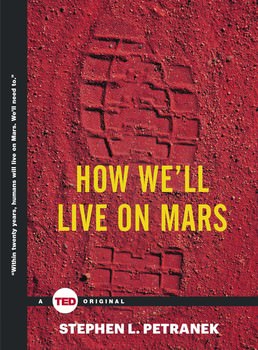Every great adventure begins with a dream. Explorers look into the unknown and set a course for discovery. Many years ago, the US launched men off planet Earth and hurtled them to the Moon. The next great space milestone is certainly to put a human boot print on Mars. In this dream and adventure of exploration, women and men will not only walk on Mars, but inhabit it.
This aspiration of putting humans on Mars is not a new one. As a spacefaring nation, we could have reached there decades ago. In How We’ll Live on Mars, author Stephen L. Petranek examines how we’ll get to Mars within this century and discusses the opportunity for a potential settlement on the Red Planet.
Find out below how you can win a copy of this new book.
As a species it seems necessary and imminent for humans to exist off this singular planet we currently reside on. How will our journey to Mars happen? What are the pitfalls? And, most importantly, who is leading the charge?
Petranek discusses how private companies are filling a vacuum left by NASA’s mothballing of the Saturn V. NASA’s primary focus on the shuttle and then its retirement has left us currently unable to launch humans from US soil. Elon Musk and his Space Exploration Technologies Corp (SpaceX) are given proper attention in this book thanks to their accomplishments thus far and their push for further achievements including a goal of Mars. Other private companies and in fact, other nations, are setting their sights on sending rovers to and eventually occupying Mars.
Chapter 6 of this book is titled “Living on Mars.” Petranek aptly notes, “Humans need four things to survive on Earth – food, water, shelter, and clothing. Humans need five things to survive on Mars – food, water, shelter, clothing, and oxygen. The successful procurement of these five essential resources will secure humanity’s future as an interplanetary species.”
This presents a major hurdle. For example, an important goal is finding accessible water – a key ingredient for human survival. Making potable water on a planet far from home is not a simple task, but it is a possible one. The challenges for survival do not end there.
How We’ll Live on Mars, a TED Books original publication, is a quick and worthy read. Stephen L. Petranek’s writing style is fluid; the information is well presented and thoughtful. The first human footprint on Mars is fast approaching reality. As a species we will tune in to watch the broadcast – albeit one with a delay for the signal travel time – of a major milestone in history. This book gives a concise examination of where we’ve been, what we’re likely to see on the road to get there and what will happen once on Mars. I recommend adding this to your reading list.
How We’ll Live on Mars is published by Simon & Schuster. Find out more about the book here.
Thanks to Simon & Schuster, Universe Today has three copies of this book to give away to our readers. The publisher has specified that for this contest, winners need to be from the US.
In order to be entered into the giveaway drawing, just put your email address into the box at the bottom of this post (where it says “Enter the Giveaway”) before Wednesday, July 15, 2015. We’ll send you a confirmation email, so you’ll need to click that to be entered into the drawing. If you’ve entered our giveaways before you should also receive an email with a link on how to enter.


Hi Eva,
Engineering & Psychology?
You learned to wave your hand over metal and say: And now you’re bolt?
Sorry for the joke …
but its a rare combination. Science & Fantasy, sort of. 😉
Forget about Mars ; Concentrate on colonizing the MOON and constructing a revolving Space Station connected by a Space Elevator connected to Earth
As much as people are working on the problems with a space elevator, I don’t think we’ll ever have one in operation that will justify the costs. Here’s why: the space station will have to have an orbit high enough to put tension on the elevator cable. This opens the cable up to flying space debris and actual low Earth orbit space flights. Even multiple cables won’t solve the problem as any two cables at any time could get sliced by micro-meteors. This is really bad news if people are in transit at the time. The elevator capsule would have to have an emergency break away system to break away and move itself far from the cable nearly instantly to avoid getting caught in the recoil of a separating cable. The station itself would need some form of protection from a rebounding cable and need some form of rockets to get back on station in the event of a catastrophic failure. That is if it even survived the failure. And the ground area will need to be protected from miles of rebounding cable that will hit the ground with catastrophic force. Technically, we could build it. Practically, it might not be worth it. Now a Moon base is within our grasp if we hide it in a huge polar crater to help protect it from the Sun and solar weather.
Mankind hasn’t finished trashing Earth when already he wants to trash other planets.
Study them but don’t leave trash behind. It’s not natural for other worlds to be littered. look at Space!
I didn’t see the word, “trash” anywhere IN that article, George Carlin…… There are already incredibly stringent policies and procedures in place to make sure even Earth-based BACTERIA don’t ride along to other worlds already… why would we begin to “trash” them suddenly? Organic creatures produce waste any way you look at it. Biological and other-wise. It’s part of having bodies… get used to this.